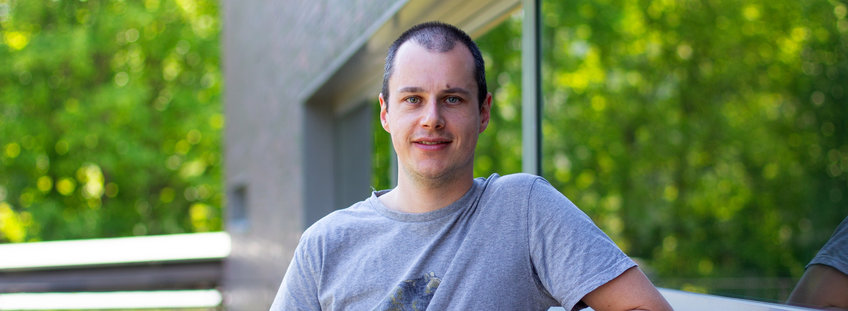
Tobias Raisch
Project Group Leader, Structural Biochemistry
Structural Biochemistry of Membrane Proteins
Research Focus
Membrane proteins perform crucial roles in signal transduction, transport of molecules across biological membranes and many other processes. Ion channels are important for neuronal signal transduction, receptors mediate communication of cells with their environment, transporters are selective gates for individual metabolites and other molecules and pore-forming proteins are a common principle to destroy cells in apoptosis and bacterial infections. Due to their central role and their presence on the cell surface, membrane proteins constitute the majority of drug targets. Yet, their available structural and biochemical information is underrepresented compared to soluble proteins. The reason for this lies in their more difficult handling, since they typically need to be extracted from their native membranes prior to analysis, and stabilization of transmembrane domains outside their biological context can be challenging..
In our group, we perform structure-function analyses of membrane proteins involved in key pathways in cellular signal transduction and small molecule trafficking. For example, Drosophila SLO represents a class of calcium-gated potassium channels that determine the tonus of smooth muscles. In addition to a central potassium-selective pore domain, four membrane-embedded voltage-sensor domains and a cytosolic, calcium-sensing gating ring enable a synergistic regulation of potassium translocation depending on transmembrane voltage potential and calcium concentrations. We study how natural and synthetic small molecules as well as peptide toxins can modulate (inhibit, activate or deregulate) potassium translocation by SLO. Such modulators are found in many fungal, spider and scorpion toxins. Structural and biochemical characterization of their binding to SLO can be a booster for the development of neuroactive drugs or highly species-selective insecticides.
Besides SLO, our work also focuses on other ion channels, their interactors and accessory subunits, as well as solute transporters, G-protein coupled receptors and pore-forming proteins. We study these systems by state-of-the-art single-particle electron cryomicroscopy (SPA Cryo-EM), electron cryotomography (Cryo-ET) and x-ray crystallography, supported by complementary biophysical methods including biolayer interferometry, mass photometry and the generation of synthetic nanobodies. Our growing collaborative network gives us access to methods such as electrophysiology, EPR spectroscopy, molecular dynamics simulations and quantitative proteome analysis.
Selected Publications
Redhardt M, Raunser S, Raisch T (2024). Cryo-EM structure of the Slo1 potassium channel with the auxiliary γ1 subunit suggests a mechanism for depolarization-independent activation. FEBS Lett.
Source
Polley S, Raisch T, Ghetti S, Körner M, Terbeck M, Gräter F, Raunser S, Aponte-Santamaria Camilo, Vetter IR, Musacchio A (2024). Structure of the human KMN complex and implications for regulation of its assembly. NSMB
Source
Raisch T, Raunser S (2023). The modes of action of ion-channel-targeting neurotoxic insecticides: lessons from structural biology. Nat Struct Mol Biol.
Source
Raisch T, Valkov E (2022). Regulation of the multisubunit CCR4-NOT deadenylase in the initiation of mRNA degradation. Curr. Opin. Struct. Biol.
Source
Pesenti ME, Raisch T, Conti D, Walstein K, Hoffmann I, Vogt D, Prumbaum D, Vetter IR, Raunser S, Musacchio A (2022). Structure of the human inner kinetochore CCAN complex and its significance for human centromere organization. Mol Cell
Source
Raisch T, Ciossani G, d'Amico E, Cmentowski V, Carmignani S, Maffini S, Merino F, Wohlgemuth S, Vetter IR, Raunser S, Musacchio A (2022). Structure of the RZZ complex and molecular basis of Spindly-driven corona assembly at human kinetochores. EMBO J
Source
Raisch T, Brockmann A, Ebbinghaus-Kintscher U, Freigang J, Gutbrod O, Kubicek J, Maertens B, Hofnagel O, Raunser S (2021). Small molecule modulation of the Drosophila Slo channel elucidated by cryo-EM. Nat Commun
Source
Yu J, Raia P, Ghent CM, Raisch T, Sadian Y, Cavadini S, Sabale PM, Barford D, Raunser S, Morgan DO, Boland A (2021). Structural basis of human separase regulation by securin and CDK1-cyclin B1 Nature
Source
Raisch T, Chang CT, Levdansky Y, Muthukumar S, Raunser S, Valkov E (2019). Reconstitution of recombinant human CCR4-NOT reveals molecular insights into regulated deadenylation. Nature Communications
Source
Wagner T, Merino F, Stabrin S, Moriya T, Antoni C, Apelbau A, Hagel P, Sitsel O, Raisch T, Prumbaum D, Quentin D, Roderer D, Tacke S, Siebolds B, Schubert E, Shaikh TR, Lill P, Gatsogiannis C, Raunser S (2019). SPHIRE-crYOLO is a fast and accurate fullyautomated particle picker for cryo-EM. Communications Biology
Source
Sgromo A, Raisch T, Bawankar P, Bhandari D, Chen Y, Kuzuoğlu-Öztürk D, Weichenrieder O and Izaurralde E. (2017).A CAF40-binding motif facilitates recruitment of the CCR4-NOT complex to mRNAs targeted by Drosophila Roquin. Nature Communications
Source
Bhandari D, Raisch T, Weichenrieder O, Jonas S, Izaurralde E (2014). Structural basis for the Nanos-mediated recruitment of the CCR4–NOT complex and translational repression. Genes Dev
Source
Boland A, Chen Y, Raisch T, Jonas S, Kuzuoğlu-Öztürk D, Wohlbold L, Weichenrieder O, Izaurralde E (2013). Structure and assembly of the NOT module of the human CCR4--NOT complex. Nat. Struct. Mol. Biol.
Source
Bhandari D, Raisch T, Weichenrieder O, Jonas S, Izaurralde E (2014). Structural basis for the Nanos-mediated recruitment of the CCR4–NOT complex and translational repression. Genes Dev
Source
Boland A, Chen Y, Raisch T, Jonas S, Kuzuoğlu-Öztürk D, Wohlbold L, Weichenrieder O, Izaurralde E (2013). Structure and assembly of the NOT module of the human CCR4--NOT complex. Nat. Struct. Mol. Biol.
Source